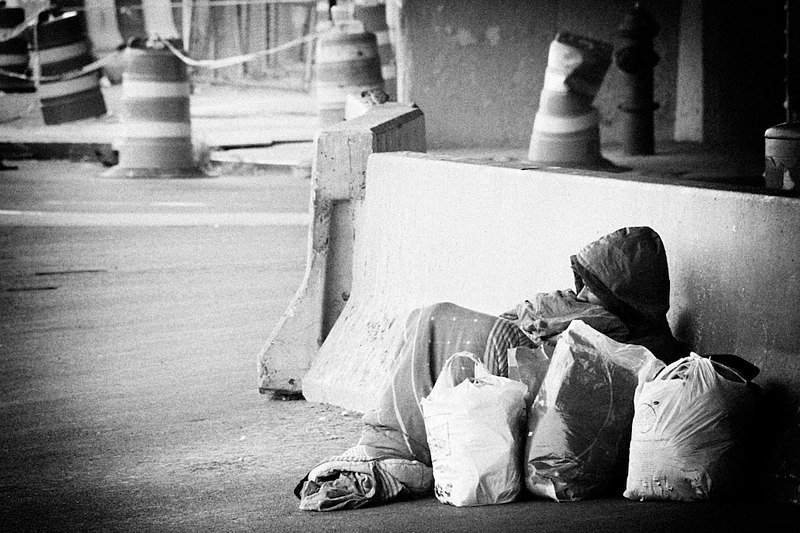- 14 3402-5578
- Rua Hygino Muzy Filho, 737, MARÍLIA - SP
- contato@latinoobservatory.org
 Foto: JMSuarez
Foto: JMSuarez
With a harsh winter spreading across the northern United States, New York City, known for its low temperatures, needs to worry about another issue more urgently than the extreme cold: rampant immigration. Since 2022, the American metropolis has been receiving thousands of immigrants from different parts of the country, especially from the south. This massive wave of individuals arriving in the city meant that public services ended up reaching a historic overload, such as the city's shelters for homeless people.
By law, New York is required to offer shelter to people experiencing homelessness, another chronic problem in the city that has been intensified by the arrival of more people without jobs or places to stay. Nearly 70,000 immigrants are using emergency shelters thiswinter however, mayor Eric Adams' administration has been making it difficult for these people to stay in shelters. Currently, there is a 60-day limit on staying in a shelter, and expulsion occurs after that. Furthermore, for those looking for work, legal barriers prevent many immigrants from accessing the New York economy, with some waiting for a document called “IDNYC”, which could help in obtaining a first salary, but with no guarantees.
Therefore, snow and bureaucracy represent two problems that intensify this issue that is spreading not only in New York, but throughout the United States as a whole, raising the importance of further analysis of the issue.
Late decisions
The migration crisis in New York City is one of the biggest challenges facing the administration of Mayor Eric Adams, who took office in January 2022. Since April 2022, more than 100,000 asylum seekers, mainly from Latin America, have arrived in the city seeking refuge and opportunities in one of the most expensive and populated metropolises in the world. However, the response from municipal, state and federal authorities was marked by delays, improvisations and conflicts, which worsened the situation of migrants and New York citizens.
One of the main problems faced by the city was the lack of adequate shelters to accommodate migrants, who often arrived by bus without prior notice or coordination. The city, required by law to offer shelter to anyone who requests it, had to resort to hotels, tents and even cruise ships to house the new arrivals. However, these solutions proved to be insufficient, inefficient and expensive, costing the city around 12 billion dollars over the next three years.
Furthermore, some of the attempts to find solutions to the crisis generated ridicule and criticism, both from public opinion and from other spheres of government. For example, the idea of using cruise ships as shelters was rejected by some as cruel and by others as luxurious, as well as facing logistical problems such as sewage. Another idea, to build tents in a parking lot in the Bronx, was abandoned after the site proved unsuitable due to rain and the risk of sinkholes.
The crisis also exposed differences between the federal government, led by Democratic President Joe Biden, and the state and municipal government of the same party. Mayor Adams accused the White House of failing New York City by not having plans to address the enormous burden its immigration policies placed on big cities. For its part, the White House said it was proud of the significant investments it made in New York City. The state's former governor, Andrew Cuomo, also clashed with the mayor, questioning the use of public resources to shelter migrants.
Criticism to Biden and the 2024 election
The problem facing the city in question is not President Biden's only headache on immigration, but several national political fronts are attacking the current White House administration on this issue, such as the Texas government. Recently, the governor of the Texas territory, Greg Abbott, was against a decision by the United States Supreme Court that allowed federal agents to access the country's border with Mexico, obstructed by the Texas National Guard. The motivation for this was that the Texas government began to place fences along the Rio Grande, which federal agents began to remove to help possible injured immigrants, generating protests and limitations on access to the site by the Texan government.
Under operation “Lone
Star”, Texas has been waging a “war” against illegal immigration and generating
discomfort for the White House, with Governor Abbott projecting himself
nationally as a major critic of the president in this regard. In a statement
released on the Texas government website, the governor criticizes the
president, insinuating that the federal administration has ordered agencies to
“ignore” the rules that send illegal immigrants to prison and reinforces Texas’
right to protect itself: “The president Biden has instructed his agencies to
ignore federal statutes ordering the detention of illegal immigrants [...].”
“Texas has the right as a state to prevent criminals from entering our state,
to arrest these criminals [...]”.
This pressure, coming from the south, makes it difficult for President Biden, elected on a platform that mixes the traditionalism of the Democrats with the current progressivism present in the party. In these moments, the chief executive acts in a way that is sometimes seen as “rough” by his Democratic supporters, but never “strong” enough to calm Republicans. On the right, Donald Trump, his possible opponent in the November election, and Nikki Haley, Trump's current opponent for the party's nomination, have been criticizing the president's administration. To give you an idea, Haley supported Governor Abbott's decision against federal forces and classified Biden's position on the issue as “absolutely ridiculous”. Trump, on the other hand, promises mass deportations and supports states' decisions to diverge from the federal administration on the issue of immigration. This brings concreteness to the statement that New York is not the only place facing immigration problems in the country. Bureaucratic, security and justice agencies are misaligned in this regard, which could severely impact this year's elections.
On the last Saturday of January, the current governor of the State of New York, Kathy Hochul, defended, during a speech, the possibility of considering the deportation of immigrants undercertain circumstances. The governor's speech clashes with the “sanctuary city” characteristic – whose legal structure is shaped in favor of immigrant protection – previously attributed to the city of New York, as a result of policies favorable to immigrant rights, such as the one to vote in local elections and the legal release of undocumented people. It is important, however, to emphasize that the hypocrisy that exists within North American politics is not new and continually contributes to the harm in relation to the permanence and dignity of immigrants in North American territory. As an example of this political disagreement, in the second half of 2022, the Immigration Reform Law Institute (IRLI) – a legal organization affiliated with the Federation for American Immigration Reform (FAIR), which projects against immigration – criticized the measures taken by councilors in favor of immigration rights, claiming that policies taken by sanctuary cities, such as New York, lead to more crime, fear and death.
With this, it is stated that the
complexity of the immigration crisis in the United States transcends the
distress of the State of New York and it is understood that the mismatch of
conceptions and the persistent hypocrisy present in American policy end up
complicating the scenario faced today, and it lacks a resolution spectrum.











